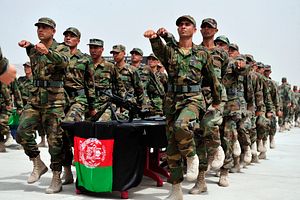The Trump administration is pursuing a radical policy shift in Afghanistan, seeking to engage in direct talks with the Taliban. As a byproduct, the administration is making highly risky concessions to the Taliban, a group labeled as “an enabler of terrorists” by the top U.S. commander in Afghanistan, and which is also working with regional intelligence organizations trying to undermine the U.S. mission in Afghanistan.
Part of the Trump administration’s policy shift, reported by the New York Times, is a proposal to withdraw the Afghan National Defense and Security Forces (ANDSF) from the least populated areas of the country, instead moving to the large cities of Afghanistan. Any such move would be a highly ill-advised and dangerous maneuver.
First, withdrawing ANDSF from places currently under their control means surrendering parts of the country to the Taliban and its terrorist affiliates and allies, and expanding their territorial gains and control over the Afghan population. Withdrawing ANDSF would not only be a betrayal to sacrifices made by these forces and the international coalition over the years, but would also mean indifference to the miseries endured by the ordinary Afghans, who expect a future that is free from the tyranny, violence, and brutal rule of the Taliban.
While highly demoralizing to the ANDSF and ordinary Afghans, an ANDSF retreat would boost the insurgents’ morale. In addition, it would provide the Taliban with much needed resources, such as new recruitment bases, poppy cultivation fields, and space to shift their training camps from Pakistan.
Contrary to the proposition that such a move would help reduce ANDSF casualties and enhance the security of main population centers, reducing the ADNF presence to large cities would put them in an even more vulnerable defensive position. Afghan forces would become easy targets to the increasingly expansionist insurgency and terrorist organizations freely operating in the country. Since withdrawal of the U.S.-led international forces from a combat role in 2014, the Taliban’s repeated attacks and campaigns to take over provincial capitals of key provinces such as Kunduz in the north, Helmand in the south, Farah in the west, and now Ghazni – just 80 miles from the capital Kabul – clearly illustrates their willingness to overrun large cities of Afghanistan.
Beyond the security concerns, an ADNSF pullback, combined with the Trump administration’s direct talks with the Taliban, undermines the Afghan government and the so-called “Afghan-owned and Afghan led” peace process. It also lends legitimacy to the Taliban and gifts them a status parallel to the democratically elected Afghan government.
Speaking of Afghan democracy, an ANDSF retreat will also negatively affect the two upcoming and highly crucial polls in Afghanistan: the 2018 parliamentary and 2019 presidential elections. Not only would a withdrawal decrease the overall number of Afghan voters and add to existing quarrels over the percentage of registered voters, but it would also make it almost impossible for the Afghan Electoral Bodies to adjust themselves for the parliamentary election scheduled for just a few months from now. Meanwhile, people running for the Afghan parliament and district councils from areas to be effectively surrendered to the Taliban – due to the proposed ANDSF retreat – would definitely resent any such move and create tensions in nearby places under the Afghan government’s control.
On the foreign policy front, the Taliban and their terrorist allies and affiliates’ undisputed expansion, as a result of the proposed ANDSF retreat, would put them geographically closer to some of Afghanistan’s neighbors that are not only skeptical of the U.S. presence in the region, but also consider the ongoing insurgency in Afghanistan a means to destabilize their respected countries. If the new proposed strategy of withdrawing ANDSF sound alarming to Moscow, Tehran, Beijing, and Islamabad, the consequences of their reaction would be highly unpleasant to both Kabul and Washington.
The threat level to the United States itself would also be elevated. If the United States justifies its presence in Afghanistan and other parts of the world as a precautionary measure to prevent terrorist attacks on its mainland, then what is the logic behind withdrawing that ANDSF from their forward operation bases in rural areas, leaving more operating space for the Taliban? Wouldn’t that make larger cities and population centers prone to more devastating terrorist attacks?
We have seen a similar strategy before, during the last years of the Soviet Union. The USSR’s “urban population-centric strategy” – leaving rural areas to the Afghan Mujahideen and concentrating their forces in the large cities and provincial capitals – proved the death knell for its ambitions in Afghanistan. If history tells us anything, then it is clear that Trump administration’s proposal of withdrawing the ANDSF from strategically important rural parts of the country would be nothing but a self-inflicted disaster.
Ghulam Farooq Mujaddidi is a protective security expert, Fulbright scholar, and independent researcher. His research interests extend from state-building challenges in war-torn countries to insurgency and suicide attacks, with a particular focus on Afghanistan.

































